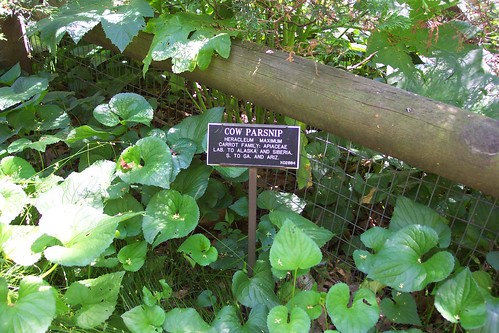The Cow Parsnip or Pushki (Heracleum maximum) is the only member of the Hogweed genus native to North America. Its classification has caused some difficulty, with recent authoritative sources referring to it variously as Heracleum maximum or Heracleum lanatum , as H. linatum, or as either a subspecies, H. sphondylium subsp. montanum, or a variety, H. sphondylium var. linatum, of the Common Hogweed (H. sphondylium). The classification given here follows ITIS.
The Cow Parsnip is found from coast to coast in North America; in the continental United States, it is absent only from the south eastern states, from Texas eastward. In the west it can be found as far north as Alaska and most of Canada. It can be found at altitudes of up to 2500 metres. Overall, it is an abundant plant and not a conservation concern, but in some localities it is becoming rarer; it is listed as endangered in Kentucky, whereas in the west it is sometimes regarded as an invasive weed.
The Cow Parsnip is a tall herb, reaching to heights of over 2 metres. It has the characteristic flower umbels of the carrot family (Apiaceae), about 20cm across; these may be flat-topped, as in the picture at right, or more rounded, and are always white. The leaves are large, up to 40 cm across, divided into lobes. The stems are stout and succulent.
The juices of all parts contain a phototoxin that can act on contact with skin and exposure to ultraviolet light, causing anything from a mild rash to a blistering, severe dermatitis, depending on the sensitivity of the individual. [1] The plant is a pernicious weed especially in pastures, where it can ruin the milk of cows that eat it.
Various Native American peoples had many different uses for this plant; all parts of it were used by one nation or another. Perhaps the most common use was to make poultices to be applied to bruises or sores. In addition, the stems were widely used for food, and in some places the leaves were also treated as an edible vegetable. The dried stems were also used as drinking straws for the old or infirm, and to make flutes for children. A yellow dye can be made from the roots, and an infusion of the flowers can be rubbed on the body to repel flies and mosquitoes.
Monday, June 11, 2007
Cow Parsnip or Pushki (Heracleum maximum)
Subscribe to:
Post Comments (Atom)

1 comment:
This stuff is fairly common in Alaska and gets real tall. We try to avoid it. I've heard some horror stories about the rash it can give you. Great blog, Maeve!
Post a Comment